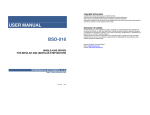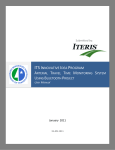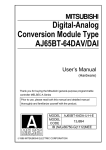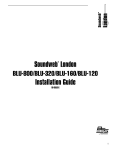Download INSPIRE OSD
Transcript
INSPIRE OSD Installation Manual Rev-D through Rev-E Hardware INTRODUCTION: INSPIRE is a GPS-based video system designed for photography applications. Besides offering a remote shutter interface for digital and film cameras, it also provides detailed navigational information. The realtime data is presented as a text overlay on the user’s existing video camera signal. In addition, the GPS data for each photo can be stored for later review. The applications for Inspire are extremely broad and so the exact installation details will vary. These instructions are best used as a basic template on how to install the system. The installer should have prior experience with similar video Figure 2, Aerial Photo View based equipment. If a R/C (radio control) system is used with the Inspire system, then good experience with them is also required. Installing and using the Inspire On-Screen Display (OSD) system requires technical skills and safety-minded operation. Under no circumstances should the telemetry data be used as the primary navigation resource. Never remotely operate any equipment unless you have direct visual contact at all times and it is safe to do so. Use of the system is at your own risk. BOARD PROTECTION The Inspire board is protected by rugged fiberglass panels and a tough clear plastic covering. However, in harsh environments it needs additional protection. Never expose it to moisture, excessive temperatures, severe vibration, or high G-forces. Doing so will damage it and void the warranty. Mobile applications must use soft foam rubber padding to protect the board from vibrations. Use enough padding to provide suitable protection. Model hobby shops sell this material for use in mounting radio control (R/C) receivers, so they are often a convenient place to obtain it. INSPIRE INSTALLATION ©2006-2007 Page 1 Nov-07-2007 MICRO GPS INSTALLATION Begin by connecting the Micro GPS module to the Inspire board using the short cable that is provided. The module is installed on the top of the Inspire OSD module within the outlined area marked “GPS” (see Figure 2). A piece of 3M adhesive-back double sided foam tape should be used for this. Once it is mounted, a piece of heat shrink tubing, or several wraps of vinyl tape, should be used to securely fasten the GPS module to the Inspire board. Do not place the GPS module near a wireless video transmitter or other strong RF sources. It should be aimed towards the sky with minimal obstructions. If this cannot be accommodated with the default mounting location then it may be mounted on another nearby surface. It is also possible to modify the GPS cable for longer lengths (up to Figure 3, Micro GPS Installation eight inches). However, this will require skillful soldering and will void the warranty if assembly errors cause damage. Figure 4, Geko Connection GARMIN GEKO 201 GPS INSTALLATION Instead of the micro-GPS module, the popular Garmin Geko 201 GPS receiver may be used (do NOT install both). The Geko is connected to Inspire at the RS232 input (see Figure 4) using the optional Garmin serial cable (p/n CABGEK-M). Or, a custom cable can be created using our serial pigtail cable (p/n CAB-SER-M) or a 4-pin Molex #50-57-9404 connector (available at large electronic component suppliers). A custom cable will also need the special GPS I/O connector that is available from Garmin. Figure 5. The RS-232 4-pin connector wiring is as follows (see Figure 5): Black Shield: Pin-1, GPS Signal Ground. White Wire: Pin-3, GPS Data In. Red Wire: Pin-4, GPS Data Out. Note: The wire colors found on the Garmin connector may vary. Please confirm your connections using a continuity meter. To avoid EMI/RFI interference issues, it is best to use shielded cable that is as short as practical. Figure 6. The Garmin GPS must be set to the NMEA mode, 4800 baud. This setting is found in its Setup->Interface->I/O format menu. Please consult the Geko 201 manual for full information. INSPIRE INSTALLATION ©2006-2007 Page 2 Nov-07-2007 BATTERY INPUT CABLE The battery input cable is equipped with a 2-conductor female BEC-JST connector (see Figure 6). A matching male cable is available separately. Red wire: Black wire: 6VDC to 14VDC battery power. Ground (power return). The battery input voltage range is 6VDC to 14VDC (185mA typical). If the Inspire onboard voltage regulator will be used to power an external 5VDC video camera then the input voltage must not exceed 7.5VDC. A large capacity 5-cell NiMH pack or 2-cell LiPO battery are fine for this task. Figure 7, Batter Input Cable Battery voltages under 5.6V cannot be used with Inspire. Your battery choice must be able to provide sufficient voltage levels throughout its useful discharge voltage range. Although the battery input is reverse-polarity protected, reversing the power leads must be avoided. The Inspire system may share the battery that is used by the other video equipment. However, do NOT share battery power with radio systems or motor equipped circuits. Doing so may cause significant EMI/RFI (electromagnetic interference) problems and adversely affect operation. AUX / MOTOR CURRENT SENSOR INPUT At the top of the Inspire board are two short heavy gauge wires. These are used to monitor DC current in highcurrent applications (up to ±75A DC). For example, the current sensor could be used to monitor the motor current of a hobby robot or small scale model vehicle. The voltage should not exceed 40VDC. Please observe standard safety precautions when working with high capacity batteries. The two sensor wires must be installed in SERIES with the load’s power source. It is customary for the series connection to be made on the positive lead of the battery. For example, to measure the current on a brushed or brushless DC motor that utilizes an electronic speed control, the leads would be connected as seen in Figure 8. Figure 8, Current Sensor Figure 9, Typical Motor Circuit INSPIRE INSTALLATION ©2006-2007 Page 3 Nov-07-2007 Please note that the current sensor’s wiring is installed *in series* with the motor circuit’s battery. It is NOT wired in parallel. Do not attempt this installation unless you fully understand the installation requirements. If the “High” and “Low” wires are installed as shown, the displayed discharge current will be shown as an unsigned number. However, if a negative labeled current is preferred, then merely reverse the two connections (swap the High and Low leads). The current monitor is best used with loads that are at least one amp. Monitoring lower currents may not offer satisfactory operation due to the 250mA resolution of the current sensor. AUX / MOTOR VOLTAGE MONITOR The Aux/Motor voltage monitor can be installed two different ways. If the current sensor is being used, and you wish to monitor its voltage, then install the V-Sel Jumper (see Figure 9). A ground wire will need to be installed from the Inspire board to the Aux/Motor battery. Inspire’s factory clear plastic covering may need to be trimmed to install the jumper. Once installed, it is a good idea to place a piece of adhesive tape over the cutout to ensure the jumper remains in place. Note: When the V-Sel jumper is installed the companion VDC+ input connector must not be used (see Figure 9, small circled area). Figure 10, Aux/Motor Voltage Input ALTERNATE AUX/MOTOR VOLTAGE MONITOR The alternate Aux/Motor Voltage monitor method uses the “VDC+” and “Gnd” inputs (see Figure 9, small circled area). This connector is a common 0.1" wide header and a variety of 2pin plugs are compatible with it. When using the VDC+ input the V-Sel jumper must be removed (see Figure 9, large circled area). The applied Aux/Motor voltage must not exceed 40VDC. Do NOT reverse the polarity or severe damage will occur. INSPIRE INSTALLATION ©2006-2007 Page 4 Nov-07-2007 RSSI VOLTAGE MONITOR The RSSI voltage monitor is available at the “RSI+” and “Gnd” input connector (See Figure 10). This connector is a common 0.1" wide header and a variety of 2-pin plugs are compatible with it. The applied voltage must NOT exceed 5.0VDC. Do NOT reverse the polarity or severe damage will occur. Figure 11, RSSI Monitor Input RS-232 GPS RECORD OUTPUT The stored GPS records can be exported to a PC using the RS-232 serial port (See Figure 11). A fully assembled RS-232 cable is available. There is also a 3-wire pigtail for those that wish to add their own PC connector. Or, a custom cable can be created using a DB-9 and a 4-pin Molex #50-57-9404 connector. Wire it as follows: Molex-1 to DB9-5 Molex-2 not used Molex-3 to DB9-2 Molex-4 to DB9-3 Figure 12, RS-232 interface The fully assembled RS-232 cable is ready to use. However, if you have purchased the 3-wire pigtail, then connect it to a DB9 female as shown in Figure 12. Figure 13, DB-9 Pinouts BUFFERED NMEA SENTENCE OUTPUT The GPS’s NMEA sentences are available for external use at the RS-232 Interface (see Figure 11). This serial output is enabled when the micro-GPS module or the Garmin Geko handheld GPS is installed. The RS-232 pigtail (available separately) can be used if the white wire is move from Molex pin-3 to pin-2. The cable pin out is then as follows: Molex-2: GPS NMEA Data Molex-1: Ground. The communication parameters are 4800 baud, 8-bits, 1-stop, no parity. INSPIRE INSTALLATION ©2006-2007 Page 5 Nov-07-2007 Video and Aux R/C Input Cables There are two R/C servo cables labeled “Vid” and “Aux,” as seen in Figure 13. They are not needed to use the OSD system and may be omitted. However, if a R/C receiver is installed, they can be used for remote operation of the OSD video and the camera shutter. The “Vid” (Video Control) channel cable is used to remotely turn the OSD video on and off. A switch or stick controlled R/C channel can be used for this. The on/off thresholds are as follows: 1.6mS or Higher is Video On state 1.4mS or Lower is Video Off state Figure 14, RC Input Cables The Aux (Auxiliary Camera/Event) channel cable is used to remotely take photos or control auxiliary circuitry. A switch or stick controlled R/C channel can be used for this. The SERVO DIRECTION parameter (see USER MANUAL, Page 10) controls the Aux channel’s on/off thresholds. The R/C signal thresholds are as follows: NORM: 1.65mS or Higher is On state 1.57mS or Lower is Off state REV: 1.35mS or Lower is On state 1.43mS or Higher is Off state On PPM R/C systems the transmitter’s ATV/EPA and Dual Rate mixes should be adjusted so that extreme servo pulse values fall within a range of 1.0mS to 2.0mS. Do not go below 1.0mS or above 2.0mS. For PCM or DSP based R/C systems, please ensure that the pulse values observe the same restrictions as discussed above. However, the PCM’s failsafe should be set so that a lost R/C signal causes the servo test screen to display ?Bad Pulse.” This will occur with failsafe servo settings that are less than 0.85mS or greater than 2.15mS. Forcing such exaggerated servo pulse values will allow the glitch counter to count failsafe events. Also, when using failsafe, the R/C-Vid servo channel must be programmed to turn on the OSD video upon failsafe detection. The two R/C inputs can be tested for proper operation using Inspire’s System Setup menu (see Figure 14). Details to the R/C Servo Test feature are discussed on Page 11 of the USER MANUAL. Figure 15, R/C Servo Test INSPIRE INSTALLATION ©2006-2007 Page 6 Nov-07-2007 Shutter Control Servo Cable The 3-pin female R/C connector provides a standard R/C signal (see Figure 15). It can be used to control a hobby servo or servo-compatible device. Servo Cable Color Code: Orange: Servo Signal output, 1mS to 2mS. Red: Servo Power (4.8V to 6V DC required). Brown: Servo Ground. Servo voltage is obtained from the two R/C input cables, which are normally plugged into a battery powered R/C receiver. If a servo is used without a receiver then a external battery must be Figure 16, Servo Cable provided. Maximum allowed servo current draw is one amp. The shutter servo cable is enabled when Inspire’s CAMERA MODE entry is set to “Servo” (see Figure 16). When this entry is chosen your shutter servo can be installed on the R/C cable labeled “Shut”. If it is set to “Direct” the servo must be removed. Full details to configuring the Camera/Event features are found in the USER MANUAL on page 10. Figure 17, Servo Mode Selected DIRECT CONNECT SWITCHED OUTPUT The remote controlled switched output is labeled as Out+ and Out(See Figure 17). It is available when the Camera mode is configured as “Direct.” This connector is a common 0.1" wide header and a variety of 2-pin plugs are compatible with it. The switched output can be setup to provide a 2-sec pulse upon a timed event. It can also turn on/off using the R/C system. A typical application is to use it to control the electric shutter on a film or digital camera. It can also be interfaced to custom electronic circuitry for application specific uses. Figure 18, Direct Connect It is an optically isolated electronic switch that can accept loads of up to 15VDC @ 10mA. Do not exceed these limits. The switch is polarity sensitive; reversing the output may damage it. Note: The special optically isolated output requires connecting a 2-wire cable to Out+ and Out-. The 3-wire female servo cable cannot be used during the DIRECT mode. The switch’s internal electrical configuration is shown in Figure 18. Figure 19, Switched Output Configuration INSPIRE INSTALLATION ©2006-2007 Page 7 Nov-07-2007 TACHOMETER SENSOR The optional tachometer sensor module is shown in Figure 19. It plugs into Inspire at the 3-pin connector labeled “Tach” (Figure 20). The actual sensor is a small IC (integrated circuit) at the face of the tach board. It measures RPM by detecting the movement of nearby miniature neodymium rare earth magnets. Although the magnets are about the size of a pinhead, they are very powerful. One can be seen in Figure 19, just below the tach board. Figure 20, Tach Sensor Two magnets are provided with each tach board. Pulling them apart can be a challenge, but try to avoid using tools on them. In a typical installation the magnets are carefully mounted 180° apart on the rotating mechanics (i.e., wheel, non-ferrous shaft, plastic hub or gear, etc.). The sensor board would be solidly mounted on a fixed structure near the magnets. Figure 21, Tach connector The clearance between the magnet’s face, and the face of the sensor IC, must be sufficient to prevent physical contact. But the spacing must not exceed 2mm or magnet detection will be unreliable. The tach can measure up to 65,000 RPM. The number of magnets that are used will determine the RPM count’s resolution as follows: 1 Magnet : 60 RPM 2 Magnets: 30 RPM 3 Magnets: 20 RPM 4 Magnets: 15 RPM 5 Magnets: 12 RPM 6 Magnets: 10 RPM Figure 22, Magnet Test Before mounting the magnets you must identify the active magnetic pole. To find the active pole, enter Inspire’s SYSTEM SETUP menu and go to the FEATURE SETUP PAGE 5 screen (see Figure 21). While observing the MAGNET COUNT entry, place the flat side of the magnet near the Tach sensor IC. If necessary, flip it over. The side that echos the “i” character is the active pole. Mark this side with a felt pen. It is the side that must face the tach sensor. If they are installed backwards they will not work! The magnets should be mounted flush with the surface. A shallow depression should be drilled at each mounting location for this. To prevent the loss of the magnet during use, very strong adhesive must be used to secure it. JB Weld epoxy works well and is stocked by hobby and automotive stores. Inspect the magnets for even spacing and balance to prevent vibration. Ensure that the sensor board is securely fastened and that all wires are routed away from moving parts. Lastly, verify that the MAGNET COUNT menu entry is set for the number of magnets that are installed. INSPIRE INSTALLATION ©2006-2007 Page 8 Nov-07-2007 VIDEO CABLES The input and output video cables are shown in Figure 22. The female connector (left side) is Video-In and the male connector (right side) is Video-Out. Mating pigtail cables are provided with each system. The cables are wired as follows: Video-Input Orange: Video signal from camera. Red: Optional 5VDC power output. May be used to power a low current 5V video camera. See note below. Brown: Video Ground. Figure 23, Video Cables Video-Output Orange: Video signal to monitor or wireless video transmitter. Red: Optional 5VDC power output (normally not used). See note below. Brown: Video Ground. Note: The video cable’s 5VDC power output may be used to power a low current video camera or other accessory. If this option is used the battery input voltage must not exceed 7.5VDC. The total combined current drawn from both cables must be less than 350mA. Otherwise, overheating of the internal power supply will cause circuit stress and possible loss of video during use. Do not use the 5VDC power output to operate high current accessories such as wireless video transmitters. EMI/RFI NOISE: TIPS FOR USING AN R/C SYSTEM WITH INSPIRE R/C (radio control) systems are very sensitive to electromagnetic interference (EMI) and radio frequency interference (RFI). EMI/RFI “noise” is undesirable because it reduces R/C operating range and can cause unexpected servo behavior. Unfortunately, video systems and other common sources generate EMI/RFI noise, so special installation care is needed to minimize problems. Interference issues can be investigated using the common R/C ground range test. Details to this test are provided with the R/C system. If the ground range test does not pass the manufacturer’s minimum recommended distance then the problem must be resolved before using the video system. DO NOT USE THE SYSTEM IF THE TEST DOES NOT PASS. Here are general tips for fighting EMI/RFI interference: ! The video equipment must not share the battery that powers the R/C system or any motor circuits. ! Use a high quality double conversion R/C receiver. Do NOT use short-range designs. ! Do not modify the receiver’s factory installed antenna. Use the full length (do not coil or wrap it). Mount it far from the video system and GPS receiver. ! Keep ALL cable lengths as short as possible. If they cannot be reduced in length, then tightly bundle up any excess. Do not combine different cables in the bundles. ! Install the video/GPS system as far from the R/C system as possible. A minimum of six inches is recommended. INSPIRE INSTALLATION ©2006-2007 Page 9 Nov-07-2007 Lastly, because the Inspire board is often plugged into the R/C receiver, it can act as a electrical pathway for a variety of EMI/RFI interference sources. In cases where the R/C interference cannot be resolved, Inspire may need to be unplugged from the R/C receiver to help restore reliable R/C range. Digital Products Company INSPIRE INSTALLATION ©2006-2007 Page 10 Nov-07-2007



















